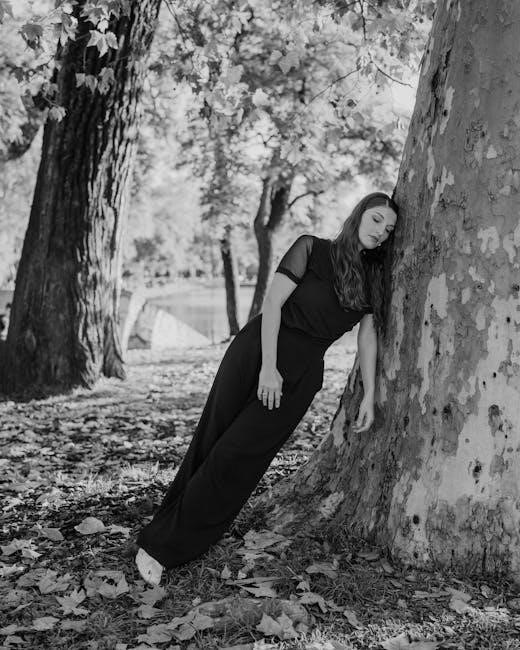The Roper-Logan-Tierney Model of Nursing is a holistic, practice-centered framework emphasizing activities of living to assess patient independence and promote recovery. Widely used in the UK, it integrates biological, psychological, and social factors to guide individualized care plans, ensuring comprehensive and culturally sensitive nursing interventions.
1.1 Overview of the Model
The Roper-Logan-Tierney Model of Nursing is a practice-centered theoretical framework focusing on activities of living and the dependence-independence continuum. It offers a holistic approach to patient care by integrating biological, psychological, and social factors; Widely used in academic and clinical settings, the model guides nursing interventions through comprehensive assessment tools, promoting tailored care plans that enhance patient independence and overall recovery outcomes.
1.2 Historical Background and Development
The Roper-Logan-Tierney Model of Nursing was developed in the 1970s by Nancy Roper, Winifred Logan, and Alison Tierney. Based on Virginia Henderson’s work, the model emphasizes activities of living and the dependence-independence continuum. Initially focusing on physical needs, it evolved to integrate psychological, social, and cultural factors, becoming a holistic framework. Its refinement in the 1980s expanded its application, making it a cornerstone of nursing practice in the UK and beyond.

Key Concepts and Framework
The Roper-Logan-Tierney Model focuses on activities of living, emphasizing a dependence-independence continuum. It provides a structured framework for assessing patient needs holistically, integrating biological, psychological, and social factors.
2.1 Activities of Living (ADLs)
The Roper-Logan-Tierney Model identifies 12 essential activities of living (ADLs), such as breathing, eating, mobilizing, and communicating. These universal tasks are fundamental to daily life and are used to assess a patient’s ability to function independently. By evaluating these activities, nurses can identify deficits and develop care plans that promote recovery and independence, addressing physical, psychological, and social needs holistically. This framework ensures personalized and effective patient care.
2.2 Dependence-Independence Continuum
The Roper-Logan-Tierney Model incorporates a dependence-independence continuum to assess a patient’s ability to perform activities of living. This continuum reflects the degree of assistance required, ranging from complete dependence to full independence. Nurses use this framework to identify a patient’s current status, set realistic goals, and develop interventions to enhance independence. It provides a clear structure for monitoring progress and tailoring care to individual needs, promoting patient autonomy and recovery. This approach ensures personalized and effective care delivery.

Theoretical Foundations
The Roper-Logan-Tierney Model integrates biological, psychological, and social factors, emphasizing a holistic approach to nursing care. It considers the patient’s life context, including cultural and environmental influences, to provide individualized care.
3.1 Influence of Virginia Henderson’s Work
Virginia Henderson’s work significantly influenced the Roper-Logan-Tierney Model, as it built on her premise that nurses play a crucial role in helping patients perform daily activities essential for recovery. Henderson’s emphasis on patient-centered care and the importance of addressing basic human needs aligned with the model’s focus on promoting independence and holistic well-being. Her theories laid the groundwork for the model’s structured approach to nursing practice.
3.2 Integration of Biological, Psychological, and Social Factors
The Roper-Logan-Tierney Model integrates biological, psychological, and social factors to provide a holistic approach to nursing care. It considers how physical health, mental well-being, and social environments interact to influence a patient’s ability to perform daily activities. This comprehensive perspective ensures care plans address the whole person, promoting recovery and independence while respecting individual and cultural contexts.

Practical Applications in Nursing Care
The Roper-Logan-Tierney model is widely applied in nursing practice to guide individualized care planning, focusing on enhancing patients’ ability to perform daily activities and achieve optimal health outcomes.
4.1 Assessment and Care Planning
The Roper-Logan-Tierney model provides a structured approach to assessment and care planning by evaluating a patient’s ability to perform activities of living. Nurses use the dependence-independence continuum to identify specific needs and limitations. Care plans are tailored to promote independence, focusing on realistic goals and interventions. This approach ensures comprehensive, individualized care, addressing biological, psychological, and social factors to enhance overall well-being and functionality.
4.2 Promoting Patient Independence
The Roper-Logan-Tierney model emphasizes promoting patient independence by identifying and addressing specific deficits in activities of living. Nurses create personalized care plans to help patients regain or adapt skills, fostering autonomy and self-care. This approach encourages patients to participate actively in their recovery, setting realistic goals to enhance physical, psychological, and social well-being, thereby improving overall quality of life and functional capacity.

Strengths and Benefits
The Roper-Logan-Tierney model offers a holistic, patient-centered approach, emphasizing independence and individualized care. Its adaptability to diverse settings and focus on biological, psychological, and social factors enhance nursing effectiveness and patient outcomes significantly.
5.1 Holistic Approach to Patient Care
The Roper-Logan-Tierney model provides a holistic approach by integrating biological, psychological, and social factors, ensuring comprehensive care. It addresses the whole person, not just the illness, promoting individualized and culturally sensitive interventions. This approach enhances patient outcomes by considering lifestyle, environment, and personal goals, allowing nurses to tailor care plans that foster independence and overall well-being, making it a valuable framework for modern nursing practice.
5.2 Cultural and Individualized Care
The Roper-Logan-Tierney model emphasizes cultural sensitivity and individualized care, recognizing the uniqueness of each patient. It considers sociocultural factors, personal beliefs, and lifestyle, enabling nurses to tailor care plans that respect diverse needs. This approach ensures care is patient-centered, addressing physical, psychological, and social aspects while promoting dignity and inclusivity, making it adaptable to diverse healthcare settings and patient populations.

Limitations and Criticisms
The Roper-Logan-Tierney model’s complexity and reliance on a dependence-independence continuum can limit its practicality. Critics argue it may not fully address the needs of all patient populations, particularly those with unique or complex conditions requiring specialized care approaches, potentially restricting its universal applicability in diverse healthcare settings.
6.1 Complexity of the Model
The Roper-Logan-Tierney model’s complexity stems from its detailed assessment of biological, psychological, and social factors, requiring nurses to evaluate multiple aspects of a patient’s life. While holistic, this depth can make the model challenging to implement consistently, especially in time-constrained clinical settings. Additionally, its reliance on a dependence-independence continuum may not always align with the dynamic nature of patient needs, potentially complicating care planning and execution for some practitioners.
6.2 Limited Scope for Certain Patient Populations
The Roper-Logan-Tierney model may have limited applicability for certain patient groups, such as those with severe mental health conditions or complex, chronic illnesses. While it effectively addresses activities of living, it may not fully capture the unique needs of patients requiring specialized care. Additionally, its focus on dependence-independence may not adequately accommodate patients with irreversible conditions or those requiring long-term palliative support, highlighting a gap in its universal application.

Comparison with Other Nursing Models
The Roper-Logan-Tierney model shares principles with other nursing models, emphasizing patient-centered care and holistic approaches. It aligns with the Nursing Process but uniquely focuses on activities of living.
7.1 Similarities with the Nursing Process
The Roper-Logan-Tierney model aligns with the Nursing Process in its systematic approach to care. Both frameworks emphasize assessment, diagnosis, planning, implementation, and evaluation to achieve optimal health outcomes. They share a focus on patient-centered care, promoting independence and addressing individual needs. The RLT model complements the Nursing Process by providing a structured method to guide care plans, ensuring holistic and evidence-based interventions.
- Systematic and structured approach to care.
- Focus on patient-centered interventions.
- Goal of achieving optimal health outcomes.
7.2 Differences from Other Models
The Roper-Logan-Tierney model stands out by focusing on activities of living and a dependence-independence continuum. Unlike other models, it explicitly integrates biological, psychological, social, and environmental factors. Its emphasis on holistic care and individualized assessments sets it apart, offering a structured yet adaptable framework for diverse patient populations and cultural contexts, making it uniquely comprehensive in nursing practice.

Cultural and Ethical Considerations
The Roper-Logan-Tierney model emphasizes addressing sociocultural, spiritual, and economic factors, ensuring care respects individual beliefs and values, promoting ethical and culturally sensitive nursing practices.
8.1 Addressing Sociocultural Factors
The Roper-Logan-Tierney model underscores the importance of sociocultural factors in nursing care, emphasizing the need to assess cultural influences, family support, and lifestyle habits. By integrating these elements, nurses can develop care plans that respect individual beliefs and practices, ensuring culturally sensitive interventions. This approach acknowledges the diverse needs of patients from varied backgrounds, fostering a person-centered and inclusive care environment that promotes health equity and optimal outcomes.
8.2 Spiritual and Economic Influences on Care
The Roper-Logan-Tierney model highlights the role of spiritual and economic factors in patient care. Spiritual beliefs often guide health decisions, while economic constraints can limit access to resources. Nurses must address these influences by providing culturally sensitive support and connecting patients to financial assistance programs, ensuring care plans are realistic and tailored to individual circumstances, thus enhancing overall well-being and recovery outcomes effectively.

Future Implications and Relevance
The Roper-Logan-Tierney model remains relevant in modern nursing, adapting to evolving healthcare needs and serving as a foundational tool in nursing education, ensuring holistic patient care continues to thrive.
9.1 Evolving Healthcare Needs
The Roper-Logan-Tierney model aligns with evolving healthcare needs by addressing chronic diseases, technological advancements, and personalized care. Its holistic approach integrates biological, psychological, and social factors, enabling nurses to adapt care plans to complex, modern health challenges. This adaptability ensures the model remains relevant in addressing diverse patient populations and dynamic healthcare environments, promoting effective, patient-centered outcomes in a rapidly changing field.
9.2 Role in Modern Nursing Education
The Roper-Logan-Tierney model is widely integrated into nursing education, providing a structured framework for teaching assessment, care planning, and holistic patient care. Its emphasis on activities of living and the dependence-independence continuum helps students develop critical thinking and cultural competence. The model’s adaptability to diverse patient needs makes it a valuable tool for preparing nurses to address modern healthcare challenges effectively.
The Roper-Logan-Tierney model is a cornerstone in nursing, offering a holistic approach that enhances patient care and education, ensuring individualized, culturally sensitive interventions for optimal outcomes.
10.1 Summary of the Model’s Importance
The Roper-Logan-Tierney model is a cornerstone in nursing, emphasizing holistic care through activities of living. Its structured approach ensures individualized, culturally sensitive interventions, promoting patient independence and recovery. Widely used in the UK, it bridges academic and clinical settings, offering a comprehensive framework for nurses to assess, plan, and evaluate care. Its adaptability to diverse patient needs underscores its enduring relevance in modern nursing practice and education.
10.2 Final Thoughts on Its Impact on Nursing Practice
The Roper-Logan-Tierney model remains a pivotal framework in nursing, fostering holistic, patient-centered care. Its emphasis on activities of living and the dependence-independence continuum has revolutionized care planning, promoting individualized and culturally sensitive interventions. By integrating biological, psychological, and social factors, it equips nurses with a structured approach to enhance patient independence and recovery. Its enduring relevance in modern healthcare underscores its value in nursing education and practice, driving positive patient outcomes and advancing the profession.